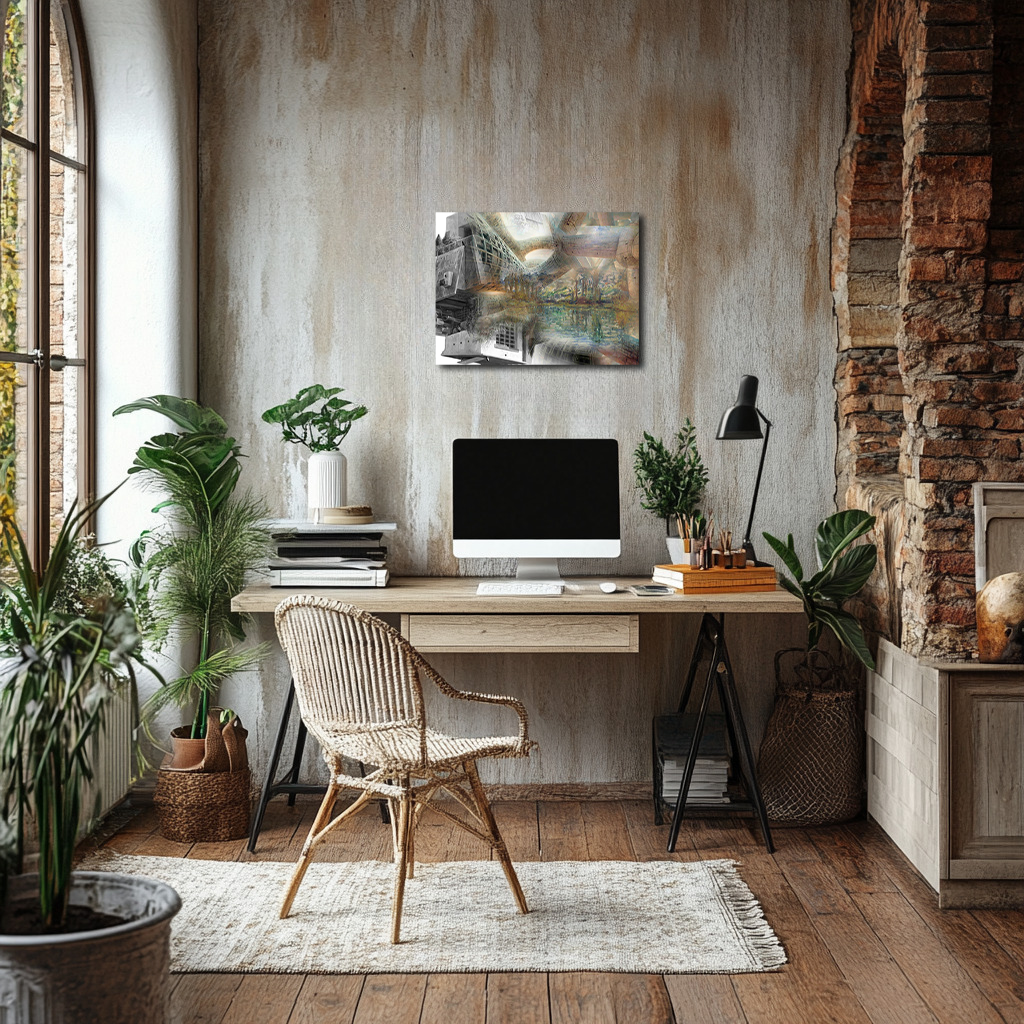Echoes of Vetheuil: The Interwoven Realities
This conceptual reimagining of Monet’s The Seine near Vetheuil (1878) transforms a serene riverscape into a surreal blend of nature and futuristic architecture. The river, once a simple reflection of the sky, now mirrors massive interwoven corridors, their metallic surfaces twisting through space. On the left, a modernist building appears upside-down, challenging traditional perspective and the concept of gravity. The right side retains the softness of Monet’s trees and reflections, yet they seem to flicker between reality and abstraction, as if caught in a moment of transition. The muted blues and earth tones of Monet’s palette contrast with the artificial grays and metallic hues, reinforcing the tension between nature and human construction. This artwork explores perception and transformation, turning the Seine into an ever-changing mirror that reflects not only light but the evolving consciousness of time itself.
Please see Below for Details…
Hotline Order:
Mon - Fri: 07AM - 06PM
404-872-4663
Claude Monet’s The Seine near Vetheuil , painted in 1878, was a testament to his mastery of light and reflection, capturing the serene beauty of the river as it flowed through the French countryside. His brushstrokes softened the division between water and sky, creating an impression of endless movement, where ripples and reflections danced in harmony with the shifting atmosphere. The landscape, though real, always felt ephemeral in Monet’s hands, as though it could dissolve at any moment into pure light and color.
In this conceptual digital reimagining, the tranquil Seine no longer belongs solely to nature but becomes intertwined with an architectural dreamscape, where past, present, and future collide. The water still mirrors the sky, but now it also reflects impossible structures—massive, interlocking corridors that twist in every direction, like the skeleton of an unknown civilization suspended between dimensions. These colossal structures rise above the landscape, neither organic nor entirely artificial, suggesting a fusion of humanity’s creation and nature’s fluidity.
On the left, a modernist building emerges, its rigid geometry in stark contrast to the ethereal flow of the Seine. It appears upside-down, defying conventional perspective, as if gravity itself has lost its authority in this world. The windows and terraces seem to look inward rather than outward, questioning whether they belong to a physical space or an illusion created by the reflection on the river’s surface. This manipulation of structure and orientation evokes a sense of disorientation, reminding the viewer that perception is fluid, much like the water Monet so often painted.
The right side of the image preserves the essence of Monet’s original work, where trees still line the water’s edge, their reflections trembling in the ripples of the river. However, these trees seem caught in a moment of transition, their forms flickering between reality and abstraction, as if they are being pulled into another existence. The horizon remains hazy, its depth extending into an unknown space where nature and technology meld into something surreal yet familiar.
The color palette of this piece enhances its duality. The muted earth tones and soft blues of Monet’s original composition remain, grounding the viewer in a sense of familiarity. But above and around these tones, metallic grays and deep, shadowy hues creep into the scene, representing the intrusion of artificiality into the natural world. The golden reflections on the water retain a warmth that contrasts with the cool, mechanical lines of the superstructures, reinforcing the tension between the organic and the fabricated.
As an artist, my intention with this piece was to challenge the way we perceive landscapes—not just as places that exist in time, but as spaces that evolve with thought, memory, and imagination. Monet painted the Seine as a living entity, its surface an ever-changing mirror of the sky and its surroundings. In this version, that mirror expands beyond the natural world, absorbing elements of architecture, digital structures, and abstract forms that transcend traditional perspective.
This reimagining asks the viewer to contemplate the idea that no place is ever fixed. Just as Monet captured fleeting moments of light, here the landscape is caught in a moment of transformation. The river remains, but what it reflects is no longer just the sky or the trees—it is the presence of human consciousness, the imprint of ideas and inventions that reshape our surroundings. The upside-down house, the twisting corridors, the shimmering reflections all exist in a liminal space between what is seen and what is imagined.
Monet’s impressionism was about capturing movement, the fleeting nature of time. This artwork continues that dialogue but expands it into the realm of the surreal, where time, space, and perception bend and merge. The Seine no longer just reflects the world—it absorbs it, reshaping reality into something dreamlike and infinite.
Add your review
Your email address will not be published. Required fields are marked *
Please login to write review!
Looks like there are no reviews yet.








